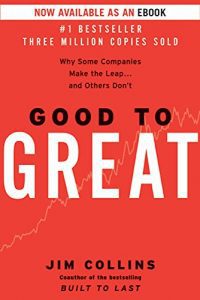
Components of a good to great framework
1. Process: Setting up yourselves towards greatness (Build up) and reaching a path that will lead you to greatness (Breakthrough).
2. Phases:
> Disciplined people: Acquiring the right leader
>Disciplined thought: Deep understanding of data and generating a set of core beliefs.
>Disciplined action: Creating the right culture where the right people will work within the core beliefs.
3. Flywheel:
Process of understanding what is required to be done for best results and initiating those step one by one.
These components can be broken into the following:
1. Level 5 Leader:
Jim breaks leadership into five levels, level 5 level being the highest. Organisations that aim to be great, require a level 5 leader. Some characteristics are:
- They think about the success of the organisation before their personal needs and wealth.
- They are generally shy but exude extreme professional will and the capacity to get the job done.
- They are modest, humble and often give the credit of success to others before themselves.
- They take responsibility for failures that occur.
2. Who before what:
- It’s not enough to get the right team of individuals. It’s important to get the right people before you know what route to take towards greatness.
- Getting the right people on board before a strategy or direction for the organisation is devised will allow more space and will discourage them from leaving if any change in direction takes place.
- The author also suggests that it is just as important to get the ‘wrong people off the bus’ as it is getting the ‘right people on the bus’.
3. Confront hard evidence:
- You cannot make good decisions until face the hard facts.
- The organization must create an environment where truth is welcomed and is heard by all.
- Leads with questions, not answers.
- Engage in professional discourse. Such discussions can turn into strong conclusions.
4. Hedgehog concept:
Jim believes businesses that go from good to great always figure out their own Hedgehog concept, a strategy that they can employ for a very long term.
These 3 questions should be considered when forming your hedgehog concept:
â–ªï¸What do you do best in the world?
â–ªï¸Which things are you passionate about?
â–ªï¸What is the key economic indicator you should focus on?
5. Disciplined Culture:
- Create a disciplined culture that knows how to operate within the boundaries of the framework of your hedgehog.
- Make sure everyone in the organization firmly agrees with the hedgehog. This will encourage discipline towards it.
- Any opportunity that does not fit with the hedgehog concept should be turned down.
6. Technology:
- It is crucial to only undertake new technology if it accelerates the current momentum of the organization.
- Start with deeply understanding which technology suits your hedgehog.
# Key Takeaways from Good to Great:
– The most successful companies have a clear and focused strategy, known as the “Hedgehog Concept,” which involves finding the intersection of what they are passionate about, what they can be the best in the world at, and what drives their economic engine.
– Great companies have Level 5 leaders who are humble, yet determined and ambitious. They prioritize the success of the company over their own personal success.
– A key factor in the success of great companies is having the right people on the bus (company) and in the right seats (roles). This involves finding the right people who align with the company’s values and goals, and then placing them in positions where they can excel.
– Great companies have a culture of discipline, where they focus on what they do best and say no to opportunities that do not align with their Hedgehog Concept.
– The concept of the “flywheel effect” is crucial for sustained success. It involves building momentum through consistent and aligned actions, rather than relying on one big breakthrough.
# Practical Application of Good to Great:
– Companies can apply the Hedgehog Concept by conducting a thorough analysis of their strengths, passions, and economic drivers. This can help them identify their unique value proposition and focus their efforts on what they do best.
– Level 5 leadership can be developed through self-awareness and a commitment to the success of the company. Leaders can also prioritize finding and developing the right people for their team.
– Companies can create a culture of discipline by setting clear priorities and sticking to them, even in the face of tempting opportunities. This requires strong leadership and a commitment to the company’s core values.
– The flywheel effect can be applied by consistently making small, aligned improvements and building momentum over time. This can involve setting achievable goals and celebrating small wins along the way.
# Valuable Insights for Leaders and Managers:
– Chapter 2, “Level 5 Leadership,” offers valuable insights for individuals in leadership roles. It discusses the characteristics of Level 5 leaders and how they contribute to the success of a company.
– Chapter 3, “First Who…Then What,” is also valuable for leaders and managers as it emphasizes the importance of having the right people on the team and in the right roles.
– Chapter 5, “The Hedgehog Concept,” provides valuable insights for leaders and managers in terms of developing a clear and focused strategy for their company.
# Effective Case Studies and Examples:
– The case study of Kimberly-Clark in Chapter 1, “Good is the Enemy of Great,” effectively illustrates the concept of the Hedgehog Concept and how it led to the company’s success.
– The example of Walgreens in Chapter 3, “First Who…Then What,” demonstrates the importance of having the right people in the right roles and how it can lead to sustained success.
– The case study of Wells Fargo in Chapter 5, “The Hedgehog Concept,” effectively illustrates the concept of the flywheel effect and how it contributed to the company’s success.
Leave a Reply